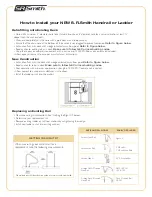
6
GB
O R I G I N A L I N S T R U C T I O N S
Read and keep the Instruction Manual before you start working on the ladder. When sharing a ladder, deliver also the
Instruction Manual.
BEFORE USE
Make sure you are fi t enough to use the ladder, as certain medical conditions, abuse of medication, alcohol or drugs may make
the use of the ladder dangerous.
When transporting the ladder on the car rack bars or in a van/truck, make sure that it is secured to prevent damage.
After delivery and before fi rst use, check the ladder to make sure it is in a good working order and all the parts are functional.
At the beginning of each working day with a ladder, a visual check must be made to ensure that it is not damaged and that it can
be used safely.
Regular and scheduled inspections are required for professional use.
Make sure that the ladder is suitable for the job to be done.
Do not use a damaged ladder.
Remove any dirt from the ladder, such as fresh paint, mud, oil or snow.
Before using a ladder for work, a risk assessment must be carried out, taking national regulations into account.
LADDER STANDING AND LIFTING
Erect the ladder in the correct position, that is, for a leaning ladder, at a correct angle (inclination angle of approx. 75°, i.e. the ‘1 in 4’ rule)
and with steps or rungs positioned horizontally, and for the stepladder, at a fully opened setting.
If a ladder is equipped with locking devices, these must be fully enabled before you step on the ladder.
The ladder shall be stood on a level, horizontal and fi rm surface.
When tilting the ladder, rest it on a fl at, not brittle surface and secure it before use by tying it or using a suitable stability device,
for example.
Never stand a ladder from the higher level.
When standing a ladder, consider all risks of possible collision with pedestrians, vehicles or doors, for example. Take all possible
steps to secure doors (except fi re exits) and windows in the work area.
Identify all electrical hazards in the work area, such as overhead lines or other exposed electrical equipment.
Stand ladders on their feet, not on rungs or steps.
Do not stand ladders on slippery surfaces (e.g. ice, shiny fl oor or heavily contaminated fi xed surfaces) unless additional measures
have been taken to prevent the ladder from slipping, or it has been made sure that the contaminated surface is suffi ciently clean.
USING LADDERS
Do not exceed the maximum total load suitable for a type of ladder or platform to be used.
Do not overreach, make sure your belt buckle (navel) stays within the stiles, and keep two feet on the same step/rung while
working on ladders.
Do not step from an inclined ladder to access a higher level without additional protection, e.g. tying the ladder or using a suitable
stabilising device.
Do not use a stepladder to access another level.
Do not work off the top three steps/rungs of the leaning ladders.
Do not work off the top three steps/rungs of a stepladder without a platform and horizontal guard rails for your hands/knees.
Do not stand on the top four steps/rungs of a stepladder fi tted with an additional extension ladder.
Ladders should only be used for light work in a short period of time.
Use a non-conductive ladder for any unavoidable electrical work.
Do not use the ladder outdoors in adverse weather conditions such as strong wind.
Do not allow children to play on the ladder.
Take all possible steps to secure doors (except fi re exits) and windows in the work area.
Face the ladder when ascending or descending.
Maintain a strong handhold when going up or down the ladder.
Do not use a ladder as a bridge.
Wear suitable footwear when climbing up or down the ladder.
Avoid excessive side loading, e.g. drilling into bricks or concrete.
Do not stand for a long time on a ladder without taking regular breaks (fatigue is a danger).
Leaning ladders used to access another level must extend at least 1 metre above the point of the ladder resting point.
When carrying any equipment during work on a ladder, ensure it is lightweight and easy to carry.
Avoid works which involve lateral loads on stepladders, such as drilling into hard materials (e.g. bricks or concrete).
Maintain a handhold during work on the ladder or take additional safety measures if it is not possible to maintain it.
































